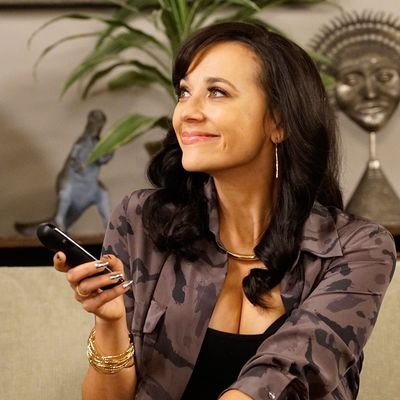
Sibling relationships in sitcoms are invariably studies in contrast, two or more characters conceived as a reaction to one another. Black-ish’s sibling pairings are no different. Zoey is the effortlessly cool older sister and tastemaker, while Junior is the straitlaced nerd-culture omnivore. Jack is goofy and fun-loving, while Diane is all crafty business. Dre loves the ladies, while Rhonda loves … other ladies.
“Sister, Sister” introduces Rashida Jones as Santamonica, Rainbow’s other sibling and the one designed to be her polar opposite. Rainbow’s brother Johan (Daveed Diggs) is also Rainbow’s opposite in a sense, as the family ne’er-do-well who gets by on his sister’s generosity instead of finding a real job. Santamonica at least shares Bow’s work ethic, if you assume emptying a Champagne flute in another woman’s face can be considered work.
She’s now the breakout star of Rich Wives, a Bravo-style, kitty-can-scratch reality soap, following her lucrative divorce after three months of marriage to a pro athlete. Santamonica is not just different from Rainbow; she’s different in a way designed to drive Rainbow insane. When Santamonica shows up to report on the latest chapter of her life, the contrast between the sisters is immediately obvious. “The only thing she and Rainbow have in common is a ridiculous name,” Dre says. (At least Rainbow’s is only two syllables and easy to abbreviate, so she got off much easier than her sister.)
At first, it seems like the Rainbow-and-Santamonica plot will unfold like a broader version of “Value,” the Atlanta episode that explored the judgments and misconceptions underlying a friendship between two black women on very different paths. “Sister, Sister” is that, sort of, just by virtue of the show Black-ish is. Rainbow’s anxiety about African-American media representation is well-documented, so it’s hard to imagine that the white gaze doesn’t factor in to her discomfort with Santamonica’s new public persona. Rainbow says she’s frustrated with her sister’s lifelong refusal to apply herself to intellectual and practical concerns. But there’s also some implicit frustration for Rainbow with the image of black women her sister is broadcasting to the world.
Nevertheless, the script by Anya Adams is more of a meditation on Rainbow and Santa’s inability to relate to each other’s lives than a commentary on reality TV’s depictions of black women. Bow voices her concerns to Dre, who, in a rare moment of mature insight, suggests Rainbow spend more time trying to get to know who Santamonica actually is instead of trying to turn her into someone else.
So Bow makes an earnest effort only to find out that with Santa, what you see on Instagram is what you get, give or take a filter. Johan and Alicia, the trio’s mother, have convinced themselves that Santamonica’s shtick is some kind of sophisticated meta-commentary. But Bow sees firsthand that Santa’s selfie-sticking, hashtagging celebutante lifestyle isn’t an act or a piece of elaborate performance art. When Bow shows Santa a feature about her work in a medical trade publication, Santa can’t stop talking about how big Bow’s boobs look in the head shot.
Alicia, played by the great Anna Deavere Smith, smacks Rainbow down when Bow tries to suggest her more traditional accomplishments made her the favorite child. Alicia says she loves her children because of who they are, not what they do. To that end, “Sister, Sister” goes further than to say Santamonica has a right to forge her own path. Alicia talks about how generous with and attentive to her family Santa is, even surpassing Bow in some ways. It’s not the biting satire Black-ish excels at, but the subtlety is refreshing.
Casting Jones as Santa is such a stroke of genius, it could make up for any good will Black-ish might have lost with the introduction of Rich Youngsta. In addition to being a wonderful comedic actress, Jones bears a striking resemblance to Tracee Ellis Ross. When I first heard about Jones’s appearance, I thought, “Oh, that might be cute,” but not until I saw Ross and Jones perched in the same frame did the impact of them playing sisters truly land. Along with Diggs, the three actors could easily pass for real-life siblings.
Santamonica is a fun departure for Jones, who usually plays characters closer to Rainbow. In fact, if you take Bow, make her younger and flightier, then plop her in the Midwest, she’s pretty close to Ann Perkins, Jones’s character from Parks and Recreation. Santa is also a challenging role, since part of the fun of “Sister, Sister” is trying to figure out exactly what her deal is. Is she just cray-cray, or is she cray-cray like a fox? The audience has to unravel the mystery of Santamonica at the same pace as her sister, and Jones infuses the character with just the right amount of ambiguity.
“Sister, Sister” feels a bit lopsided, with two thin subplots that feel like too-familiar riffs on Johnson family drama. And without Ruby or Pop Pop in the episode, the characters most likely to drop a killer one-liner can’t do what they do best. (In fairness, Deon Cole gets a great line about how a deer killed his father.) But the episode is a worthy endeavor if only because it welcomes a wonderful new member to the Black-ish ensemble.

